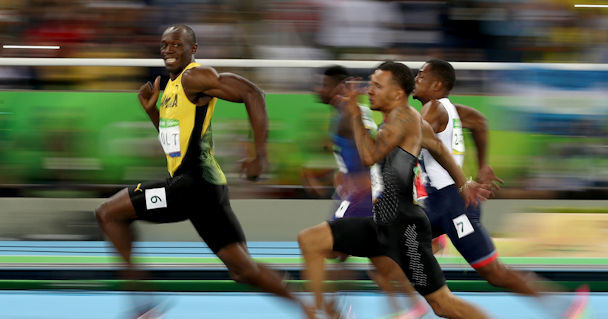What makes an iconic sports image? The story behind that Usain Bolt smiling photo
Usain Bolt is a sporting icon across the globe. He is so fast that when he runs it is hard for the human eye to track him quickly enough. With only 10 seconds in a race, how can a photographer possibly snap the image that stops a split moment in time so perfectly that it becomes a viral sensation worldwide?

/ Cameron Spencer/Getty Images
In the 100m Olympic semi-finals on Sunday, Getty Images sports photographer Cameron Spencer photographed Bolt turning his head and smiling confidently at the cameras mid-run, while his opponents trailed behind. The picture has already been described by Fox Sports as ranking “all the way up on the list” as the best image of the world’s most photographed athlete. Now the photograph has gone on to trigger a meme frenzy online and can be found all over the world’s media. As this image becomes as legendary as the moment it depicts, it’s worth looking at what sets an image like this apart from the other thousands of images out there.
When it comes to taking a great sporting image, it’s easy to assume that the photographer stumbles across it or that it is simply down to luck. In reality, several factors have to come together to make an iconic image happen.
Success rests on capturing that precise moment and there’s a lot of skill needed on the photographer’s part. To capture a quick smile at this speed is very difficult to execute. Cameron had to drop the shutter speed to around 1/40th of a second at a focal length of 135mm and pan the camera right to left in perfect unison with the subject. It was a risky move but beautifully gives an impression of a lot of speed and action, with the subjects standing out against the cleanest of backgrounds.
All our photographers are hugely experienced and knowledgeable about their subject matter and the team that went to Rio went prepared to capture moments of the biggest athletes which they anticipated to be visual gold. Cameron knew Bolt was an entertainer – he’d been shooting him for three Olympics and two World Championships and noticed that every time he competes, he simply loves entertaining the crowd. Cameron anticipated Bolt would coast past his competitors around the 70m mark so he was in position and ready when Bolt looked over and smiled.
For any sporting picture to work it has to define that moment – that very moment which catches the essence of the athlete and shows that special characteristic elevating sports people above mere mortals to become sporting Gods. Using his skill to catch what seems like a cocky smile, as well as the incredible speed and dominance that the pan creates, Cameron captures the moment Bolt knows he is going to win – his smile tells you this, as do the competitors trailing behind him.
There is another important reason that this image went viral and will go down in history as an iconic portrait of Bolt: it shows a new and unique perspective of an event and personality we know and love. The Olympic Games is a widely filmed event which attracts many viewers. What imagery can do is show people something they didn’t catch, and produce the 'wow factor' of an event you may already be familiar with. No one has ever seen a moment like this, so it sparks the interest of the viewer and the world’s media who are looking for a new angle on an extraordinary story.
Finally, this image tells a very clear narrative. All visual cues in the frame tell you what is about to take place and what Bolt is thinking. Photographers are storytellers – they just use a camera instead of a pen to document events. So when you have a skilled sports photographer, who knows his subject well, there is huge potential for his images to tell you a story about this athlete or event which you would otherwise have missed.
That people around the world are enjoying this image so much is exciting. We believe passionately in the power of images to move the world, so if it brings a smile to your face then we have done our job.
Ken Mainardis is vice president of sports imagery at Getty Images. Photo courtesy Cameron Spencer/Getty Images
